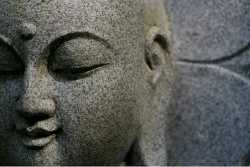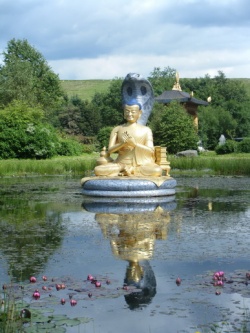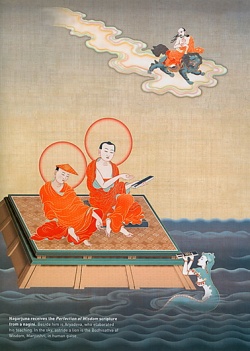The Middle Way
Two essential points of traditional Buddhist teaching are the primacy of direct non-conceptual experience, and the importance of adopting a middle way between various extremes of view and practice.
The significance of the first of these is that even although Buddhism has developed and utilized various doctrines, it is not dogmatic. Whether it is the Buddha advising disciples to leave the raft of dharma behind once one has reached the other shore, or Zen teachers urging their students not to mistake the finger pointing toward the moon for the moon itself, both views and techniques are always regarded as vehicles not endpoints in themselves. This point is taken up with particular zest in Dzogchen where in the Kunjed Gyalpo of Garab Dorje we are told that there is no view on which one has to meditate, no commitment one has to keep, and no conduct one has to adopt or abandon. Why? Because holding even such lofty notions as views, commitments, and conduct obscures the natural primacy of the non-conceptual state.
The Buddha taught the middle way as the path between desiring pleasure and denying pleasure. The Buddha also characterized his approach as one that avoided the extremes of eternalism and nihilism. Eternalism is the view that there are definite, enduring divine entities that constitute the real nature of things, while nihilism is the view that the divine is absent from the world and that nothing essentially matters or means anything.
The Buddha critiqued traditional religions, such as the priestly Vedic tradition in India, as being dogmatic, literalistic, and assuming a great deal on the basis of authority and revelation which was not verifiable in any direct way. However, to deny the fixed actuality of the mythical constructs and affirmations of traditional religion is not to deny there is no spiritual meaning in tradition, only that specific expressions of that meaning are not ultimately valid. Nihilism, the opposite extreme, not only carries negation too far in denying experience itself, but is also inconsistent in that by asserting itself as a view it attempts to make an affirmation of negation. The right understanding is to realize that there is no basis for affirmations or negations about reality. In fact, to follow either of these extremes obscures the natural clarity of experience when experienced purely as it is.
In the Mahayana tradition, the doctrine of the middle way is given a more subtle and radical reading by Nagarjuna who denied validity to any conceptual construct whatsoever. In the Mulamadhyamakakarika he shreds the philosophical affirmations of his day, both Buddhist and non-Buddhist, concluding that even the distinction between samsara and nirvana is meaningless inasmuch as they too are conceptual points of reference. All distinctions, all mental constructs of whatever grade and type, are empty, shunya, when experienced in primordial non-dual awareness.
The difficulty with Nagarjuna’s radical denial of validity to any construct we could make about reality is that Buddhist teachings themselves are constructs, and silence alone would not make a very lasting tradition. This difficulty is addressed in the doctrine of two truths. In the absolute sense, Nagarjuna is correct, nothing can be posited about reality, for every statement about reality is incomplete and hence untrue. On the other hand, in a relative sense, we can speak to the incompleteness of our experience with preciseness and clarity.
Making this distinction between absolute truth and relative truth preserves the Buddhas’s fundamental adherence to the primacy of direct non-conceptual experience. It also allows full elaboration, on a provisional basis, of the middle path in terms of presenting specific views and practices that help one attain that experience.
However, one is still left with certain questions as to how the relative arises out of the absolute and vice versa. How can any amount of relative practice and insight enable one to experience the absolute? Aren’t they two entirely different orders of understanding? Where is the unity in such a vision? Is enlightenment merely non-conceptuality? If we stop thinking does everything become clear? Buddhism is often understood in such a fashion, as merely being a means to become tranquilly but blankly present. Through meditation, all thought and conflict are abandoned, and one is left the simple pleasures of being alive – the taste of fresh water, the warmth of the spring sun, and the smell of flowers.
Nargarjuna’s analysis was more radical than this. Not only is thought fleeting and provisional, but experience itself is just as fleeting as provisional. The water you are drinking is not real, nor are you, the drinker of the water, real either. Both you and the water, as well as your thoughts about all of this, are all relative, temporal appearances without any ultimate standing.
Nargarjuna denied validity not only to constructs, but also denied validity to dharmas, the constituent elements of reality as posited by the early Buddhist schools. The early Buddhists said that we fundamentally misperceive experience by assuming there is a solid self experiencing everything when in reality we are merely a bundle of aggregates – thoughts, sense-perceptions, feelings, and so on. The perceived world is the same. What we call a cart is in reality just an arrangement of wood and other material , and that no actual cart exists. Everything is only a temporary arrangement of elements. Hence, there is no perceiver and nothing perceived, only dharmas – basic elements of experience – combining, dissolving and recombining themselves in various ways. In a manner somewhat similar to arguments in modern physics, Nargarjuna questioned what dharmas themselves were made of, and demonstrated that they are as much a fiction as anything else.
What do we experience? Is all of our experience unreal? Some Buddhist schools appear to go this direction. The world is not only suffering, but a complete fabrication – one should detach oneself as completely as possible. Buddhist teachings are a fabrication as well, but useful in helping one cut through to emptiness, where the world is clearly perceived as a complete void, lacking any substance or essence whatsoever. Nothing is real, and there is no one to perceive this unreality, but compassion entails that we help sentient beings as best we can, by sharing with them this realization and the relative practices that bring about realization of this ultimate truth.
At some point, as one carries this approach to its logical conclusion, one will wonder, where the middle way that cuts between extremes has disappeared to. Asanga and Vasubandu modified the doctrine of the two truths in such a way as to preserve the depth of the Nagarjuna’s analysis and yet preserve continuity with our basic experience of the world.
Vasubandu accepts the critique of emptiness as it applies to conceptual constructs, but does not extend emptiness in the same way to experience. As to concepts, Vasubandu would agree that conceptual constructs about reality are essentially false, because the immediacy of reality is always free of concepts. Thus one should avoid any fixed assertion or set view about what is, since attachment to such views leads to suffering. All thoughts are empty in that they are abstractions of the full reality of direct experience.
Direct experience is empty in a different way. It is not false in the way that concepts are. It is like a dream. In a dream one does see, feel, hear, taste and touch what seem to be actual objects. We can remember these experiences. Yet the dream is within our mind. The dreamer and the dream are one. So it is with our life in the natural world. Various causes and conditions interweave through countless events causing various appearances to arise. These appearances are tightly woven into our stream of experience. It is consciousness that causes these experiences to arise. This arising and the quality of consciousness that determines our experience comes from seeds planted by past experiences. These seeds reside in a storehouse consciousness, the alaya-vijnana. Thus, the past sets in place karmic propensities that ripen when conditions are appropriate and set into motion event-moments.
Appearances are dualistic by nature. One sees. One hears. One experiences. There is a natural experience of separation between the doer and what is happening. Even though we course along, immersed in what we have realized is a rather disordered world, we feel a sense of independence. And that independence is as real to us as the situations we encounter. Some Buddhist schools teach that all of this is entirely empty, devoid of meaning, without value – nothing at all is really there. However, Yogacara sees the dynamic nature of the oppositions that enable the dream to have appearance. Appearances are real, but not the complete reality. The natural world exists within waking consciousness, as the dream exists within the consciousness of sleep.
Conceptual constructs and appearances constitute two different levels of provisional reality for Vasubandu. Ultimate reality is the underlying emptiness that is reflected through appearances and thoughts. Ultimate reality is Suchness, the completely real, the signless, the ground of all events, pure non-dual presence.
In terms of being, conceptual constructs do not exist in that they are merely wispy descriptors of reality, not reality per se. Appearances exist, but not in the way they appear, differentiated and objectified. The ultimate contains both the existent and the non-existent but its own ontological status is undefined. Since concepts do not have an actual existence, they are neither permanent nor impermanent. The natural world of appearances is characterized by impermanence. The world of appearances is the world of birth and death, in which everything that arises eventually dissolves. The ultimate suffers only the impermanence of its descriptors.
Vasubandu interprets the Four Noble Truths in terms of this understanding. Suffering caused by conceptual constructs (most of our suffering) is unnatural and unnecessary. Suffering caused by direct experience is natural suffering which is part of being within the dream evolved by consciousness. Suffering experienced within ultimate reality is voluntarily taken on. The suffering of conceptual constructs is caused by residual karmic impressions. The suffering of direct experience arises naturally. And ultimate suffering is caused because there is no separation, no self-other distinction.
Conceptual suffering ceases when one is no longer ignorant as to the true nature of constructs, when one realizes their inherent emptiness. Natural suffering ceases when one no longer sees the natural world as permanent and differentiated, separate from oneself. Ultimately, cessation is Suchness. The path to eliminate conceptual suffering is knowledge. The path to eliminate natural suffering is abandoning attachments to things being other than they are. Ultimate truth is attained through direct realization.
Whereas the ultimate exists only in relation to the one truth, it is ultimate in three ways, as regards object, attainment, and practice. It is Suchness, the object of ultimate knowledge. It is Nirvana, the attainment of Suchness. It is the Path, the meditation that leads to Suchness.
–Vasubandu
Ultimately, there is no difference in the three realities since they are all equally existent and non-existent as is Suchness itself of which all reality is a reflection. Thus there is no difficulty making conventional distinctions drawn from the point of view of practice and realization. Dharma is conceptual, practice is natural, and realization is the ultimate understanding of Suchness.
With the non-appearance of duality, the appearance of duality vanishes, and with this disappearance, the complete non-being of duality is understood. With this non-apprehension of duality there is the apprehension of the basic Ground of Events and with this apprehension comes the skillful means by which one and others wishes are fulfilled.
–Vasubandu
The clarity of consciousness that results from seeing the emptiness of concepts and realizing the actual non-dual quality of experience gives birth both to vision and the skillful means necessary to fulfill vision. This vision is fulfilled in this very world, seen as it truly is, in its beautiful, dreamlike wholeness rather than dismissed as an illusion without value.
Thus Vasubandu corrects certain conceptualizations of emptiness that can arise from an improper understanding of emptiness. In doing this he was both reemphasizing the primacy of direct experience over conceptualized views of experience, and also reaffirming the value of the middle way over the extremes engendered by creating unnecessary distinction.
The Yogacara revaluing of reality became the basis for Buddhist practice traditions such as Tantra, Dzogchen and Zen. In these traditions, appearances are not something to be denied but form the basis of liberation itself. The word Yogacara translates to “vehicle of meditation”, and it is in its full embrace of contemplative methods and practices, and its full engagement of the phenomenal world, that Yogacara skillfully displays its realization of the ultimate and complete path.





